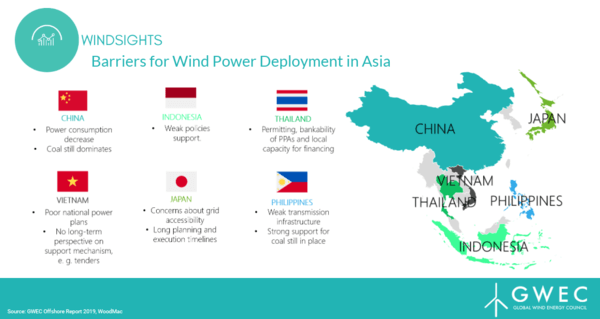News Release from Global Wind Energy Council
Wind Industry Profile of
Asia-Pacific: Potential to become the leader in offshore wind
Following in the path of solar and onshore wind, offshore wind is now gaining momentum in the race for the energy transition in Asia. In the past year, there has been a wave of studies and reports that confirm that the growth of the global offshore market has exceeded all our expectations – and it shows no signs of slowing down.
According to the IEA’s Offshore Wind Outlook, today’s offshore wind market doesn’t come close to tapping the full potential. Considering the resources available across the globe, offshore wind has the potential to generate more than 420,00 TWh per year worldwide, this is more than 18 times today’s global electricity demand. Offshore wind will, therefore, become an increasingly important piece of the energy transition puzzle – and Asia is no exception.
By 2030, the Asian offshore market is expected to have installed nearly 100 GW of offshore wind capacity, according to the Global Offshore Wind Report 2019 published by GWEC earlier this year.
This report finds that China will continue its market growth in the offshore sector, and was the global leader in new offshore wind installations, overtaking the UK for the first time. GWEC expects China to take over the number one spot for total offshore capacity in 2019, making up one-third of the global offshore wind market boosted by domestic companies such as Shanghai Electric, Mingyang, and Goldwind becoming increasingly important players in the offshore market.
Outside of China, Taiwan, Japan and South Korea are driving the development of offshore wind substantially based on ambitious political targets and support from both the government and industry.

Just last month during the inauguration of the Formosa 1, Taiwan’s first commercial offshore wind farm, the President of Taiwan, Tsai Ing-wen, asked the Ministry of Economic Affairs to ramp up their ambitions and propose a plan which would see 1 GW of capacity added annually from 2026 to 2035. This would be on top of the already set goal of installing 5.7 GW by 2025, which has served to attract the offshore wind industry and drive local supply chain development to fulfil these ambitious goals.
In Japan, 4.5GW of new offshore wind capacity is expected to come online from 2019 to 2028. Despite low wind speed conditions, South Korea also has over 3.5GW of floating wind in the pipeline.
As offshore wind electricity prices are decreasing at an extraordinary rate, offshore wind is now increasingly gaining traction in emerging markets. Countries such as India, the Philippines, Turkey, Sri Lanka, and Vietnam are now setting their sights on offshore wind to capture the economic and clean power benefits that this technology has to offer. In a new report published by the World Bank Group, Going Global: Expanding Offshore Wind to Emerging Markets, approximately 458 GW of fixed-bottom offshore wind and 551 GW of floating wind technical capacity was identified across these five Asian countries.
“While emerging markets have abundant offshore wind resources and the demand for new cost-competitive electricity sources and renewable energy, they are still witnessing significant barriers to offshore wind investment,” the World Bank report states. Nevertheless, they have an advantage of fast-tracking their offshore wind development based on the experiences, the collaboration across markets for the set-up for the supply chain, from the European offshore industry.
Scaling up offshore wind energy investment and establishing the right market design is key to accelerate the growth of global wind power installations. Offshore wind has reached its maturity in Europe thanks to solid political support and committed investments to mature the supply chain. The growing economies of scale and technological innovation – such as increased array cable voltage, foundation design, installation techniques, and hybrid solutions – will continue to drive down costs and making offshore wind more competitive in new markets, which will be the key to success of future offshore wind in the APAC region.
While offshore wind currently makes up only 0.3% of global power generation, capacity is expected to increase fifteen-fold by 2040, becoming a US$1 trillion industry over the next two decades and matching capital spending on gas and coal-fired capacity of the same period. If the policies and government support are in place, countries in the APAC region can be a leader in this important industry and take advantage of all the benefits that offshore wind has to offer.
The article is produced by the GWEC Market Intel team with reports, data ad insights exclusively available for GWEC members and as part of GWEC’s new Market Intelligence platform.
If you are a GWEC Member, access the report here.
Not a GWEC Member but interested in finding out more about the report? Get in touch with Deny Tenenblat at deny.tenenblat@gwec.net to find out how.
- Source:
- GWEC
- Author:
- Press Office
- Link:
- gwec.net/...
- Keywords:
- GWEC, Asia-Pacific, offshore, leader, potential, outlook, UK, China, player, market, Taiwan, growth



























